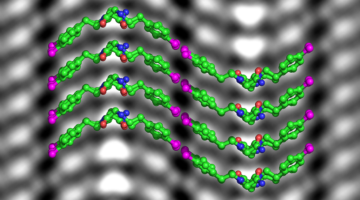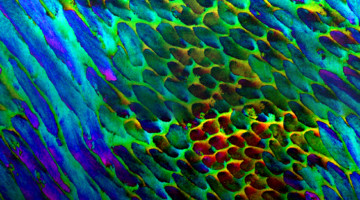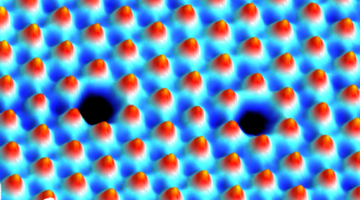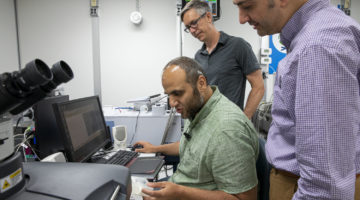KRASG12C has emerged as a promising target in the treatment of solid tumors; however, clinically viable inhibitors have yet to be identified. Here, researchers report on structure-based design and optimization efforts, culminating in the identification of AMG 510, a highly potent, selective, and well-tolerated KRASG12C inhibitor currently in phase I clinical trials (NCT03600883). Read more »
Freeze Frame: Scientists Capture Atomic-Scale Snapshots of Artificial Proteins
Protein-like molecules called polypeptoids have great promise as precision building blocks for creating a variety of designer nanomaterials. In this study, rsearchers used cryo-EM, a technique originally designed to image proteins in solution, as well as x-ray scattering techniques, to characterize the structure of polypeptide nanosheets. Read more »
ALS in the News (December 2019)
- Six Berkeley Lab scientists named AAAS Fellows
- Berkeley Lab names Robert Kostecki director of the Energy Storage and Distributed Resources Division
- New material captures and converts toxic air pollutant into industrial chemical
- The beauty of imperfections: Linking atomic defects to 2D materials’ electronic properties
- Mechanisms of soft tissue and protein preservation in Tyrannosaurus rex
- Scientists explore Egyptian mummy bones with x-rays and infrared light to gain new insight on ancient life
- New understanding of antibiotic synthesis
- Go with the flow: Scientists design better batteries for a renewable energy grid
- Cage molecules act as molecular sieves for hydrogen isotope separation
- Graphene in the making
- Jennifer Doudna honored with two prizes
Genetic Blueprint for the Bioproduction of an Antidepressant Drug Candidate
A set of genes from a marine bacterium has been found to encode the biosynthesis of a promising antidepressant drug candidate. This work, which used the ALS to solve the structure of a key enzyme, could enable industrial-scale bioproduction of the drug in ways that are more efficient and sustainable than chemical synthesis. Read more »
Crystal Misorientation Toughens Human Tooth Enamel
Researchers discovered that, in the nanoscale structure of human enamel (the hard outer layer of teeth), slight crystal misorientations serve as a natural toughening mechanism. The results help explain how human enamel can last a lifetime and provides insight into strategies for designing similarly tough bio-inspired synthetic materials. Read more »![]()
![]()
Argon: Not So Noble in Earth’s Core
Researchers demonstrated the synthesis of a thermodynamically stable compound of argon and nickel at temperatures and pressures representative of the Earth’s core. The ability of argon, a noble gas, to react with other elements under these conditions may help solve outstanding geological questions, including the “missing argon paradox.” Read more »![]()
A High-Pressure Compound of Argon and Nickel: Noble Gas in the Earth’s Core?
Researchers demonstrated the synthesis of a thermodynamically stable compound of Ar and Ni at thermodynamic conditions representative of the Earth’s core. The results suggest that the abundance of Ar in the Earth’s core is beyond a simple solubility of Ar in molten Ni–Fe but in chemical reactions in nature. Read more »
The Beauty of Imperfections: Linking Atomic Defects to 2D Materials’ Electronic Properties
Two studies reveal surprising details on how some atomic defects emerge in transition metal dichalcogenides (TMDs), and how those defects shape the material’s electronic properties. The findings could provide a more platform for designing 2D materials for quantum information science and smaller, more powerful optoelectronics. Read more »
Machine Learning Helps Stabilize Synchrotron Light
Researchers showed that machine learning can predict noisy fluctuations in the size of beams generated by synchrotron light sources and correct them before they occur. The work solves a decades-old problem and will allow researchers to fully exploit the smaller beams made possible by recent advances in light source technology. Read more »![]()
![]()
Scientists Explore Egyptian Mummy Bones With X-Rays and Infrared Light to Gain New Insight on Ancient Life
Researchers from Cairo University worked with teams at the ALS to study soil and bone samples dating back 4,000 years. The experiments are casting a new light on Egyptian soil and ancient mummified bone samples that could provide a richer understanding of daily life and environmental conditions thousands of years ago. Read more »
- « Previous Page
- 1
- …
- 48
- 49
- 50
- 51
- 52
- …
- 83
- Next Page »








